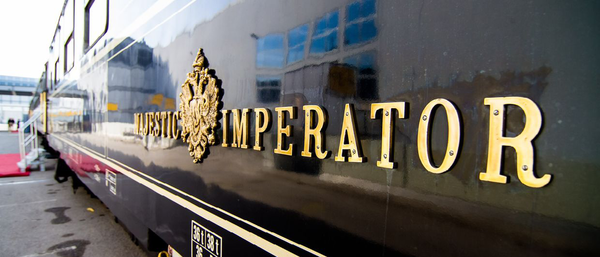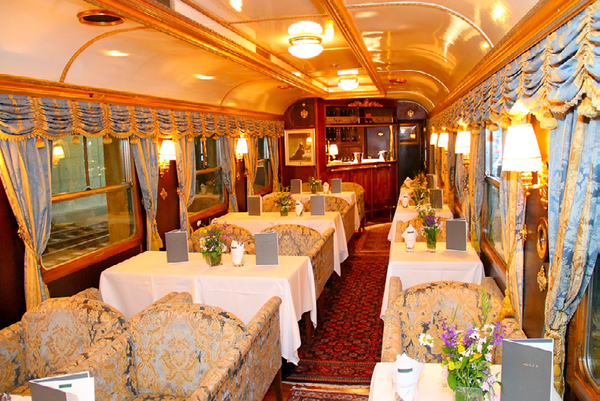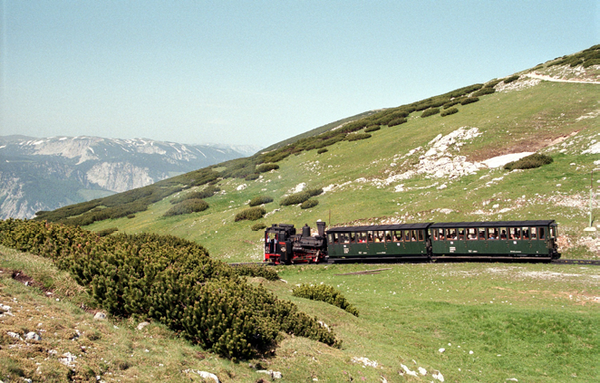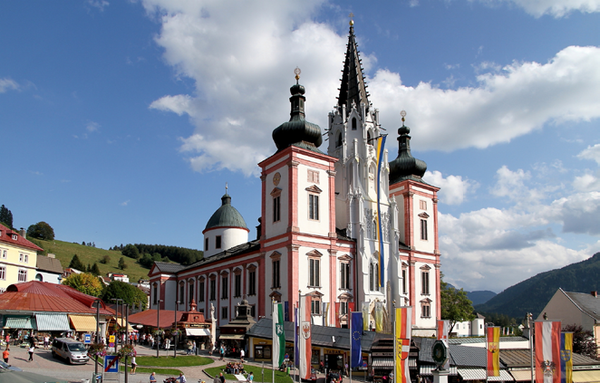Trains in Austria

오스트리아는 유럽에서 최초로 기차를 도입한 나라도 아니고 빈의 자매도시 프라하, 부다페스트처럼 아름다운 기차역도 없다. 하지만 알베르크반, 브렌너반, 젬머링반 등 아름답고 인상적인 기차 노선이 있어 오스트리아 횡단 시 중요하게 이용된다.
유럽의 열차는 오스트리아 저지대의 아름다운 호수 및 부르겐란트에서 높은 고산지대에 이르기까지 편안하게 이동할 수 있는 가장 좋은 수단이다. 일부 국제선은 매일 해발 1,300m를 오르내린다.
젬머링 노선으로 시작해보자. 젬머링은 빈에서 이탈리아 베네치아로 가는 노선에서 알프스의 가장 낮은 교차점이다. 요즘은 높이 올라가는 게 그리 어렵지 않아 보이지만, 여전히 표준 철도 차량으로 21km 속도로 459m를 오르는 것은 어려운 일이다. 이 철로는 13년간 계획하고 건설하여 1854년에 개통되었는데, 첫 100년 동안은 운행을 위해 특별히 강력한 기관차가 필요했다.
현대는 화물열차에만 2개의 엔진을 필요로 하고 일반 여객열차는 힘이 좋은 일반 표준엔진을 사용한다. 이 노선은 여러 개의 고가교와 거친 협곡을 지나 산으로 가는 최단거리로 여러 개의 터널을 통과하며, 빈에서 이탈리아와 오스트리아 남부까지 연결하는 주요 철도 노선이다.

이 여행의 가장 높은 지점인 젬머링좌(座)에는 눈 덮인 산과 구식 호텔, 겨울의 스키와 레크리에이션을 위해 지난 몇 세기 동안 지은 아름다운 디자인의 빌라들을 시작으로 놀라운 풍경이 기다리고 있다. 젬머링은 빈에서 92km밖에 떨어져 있지 않다. 빈에서 베네치아나 다른 곳으로 갈 때 유럽에서 ‘벨몬드 베니스 심플론 오리엔트 익스프레스’의 일등석 풀서비스를 이용하면 가장 호화로운 열차에서 오스트리아의 아름다운 풍경을 보게 될 것이다. 만약 여러분이 시간은 많지 않은데 멋진 풍경에서 근사한 점심이나 저녁을 즐기고 싶다면, k.u.k Hofsalonzug ‘황제의 철도여행’을 권한다.
젬머링 가까이 슈니베르크의 톱니궤도 철도는 1897년 6월 1일 푸흐베르크/슈니베르크에서 개통했으며 1,800m 산꼭대기까지 올라간다. 그 시작은 증기 기관이었으나 몇 년 전에 보다 현대적인 전차로 업그레이드했는데 아직도 하루에 한두 번은 낡은 증기 기관차를 예약하고 탈 수 있다.
톱니궤도철도는 보통 이 경우처럼 20%의 등반 속도로 가파른 산을 오르는 데 주로 사용된다. 물론 이 철도가 유일한 톱니궤도철도는 아니며 짤츠캄머굿에서 샤프베르크산을 오르는 상트 볼프강 등 유럽 내 다른 곳에서도 많이 볼 수 있다.

오스트리아의 대부분의 철도는 1850년부터 1918년까지 오스트리아-헝가리제국의 프란츠 요제프 1세 황제가 세 가지에 역점을 두고 건설하였다. 첫째, 제국 내에서 빠르게 이동하며 무역을 증진시키고 군대를 지원한다. 둘째, 알프스의 협곡에서 귀중한 미네랄과 목재를 옮긴다. 셋째, 황제의 사냥과 휴양지로 가는 길을 편리하게 한다.
산악철도의 경우 공사비를 절약하기 위해 표준 유럽 또는 한국 측정치수 1.435m에 비해 약 0.76m 또는 1m의 작은 치수를 사용하여 열차와 철로가 훨씬 작다. 이러한 유형의 대표적인 철도로 오스트리아 저지대의 마리아젤러반이나 티롤의 질러탈반이 있다. 1896년에 완공된 마리아젤러반은 당시 가장 긴 2.4km 터널 옆으로 1906년 이후 상트 포엘텐에서 마리아젤(알프스에서 가장 큰 성당 중 하나인 유명한 순례지)로 가는 오스트리아 최초의 전기 철도였다.
오스트리아에는 이웃 나라인 스위스와 같이 아름다운 철도 노선이 많이 있다. 다음 오스트리아 방문 시 이런 기차 여행을 놓치지 말기 바란다. 특히 하이킹을 비롯하여 여름과 겨울철의 자연을 즐기는 사람들에게는 인상적인 여행이 될 것이다.

Trains in Austria
Austria was not the first country in Europe to introduce trains nor have still beautiful train stations like in Vienna’s sister cities Praha or Budapest, but it has beautiful and impressive train routes which you can discover, like the Arlbergbahn, the Brennerbahn, Semmeringbahn and many other. All of them are still used and important to travel across Austria.
Trains in Europe are comfortable and the best way to move around, from the beautiful lakes in lower Austria and Burgenland to the alpine region high up into the mountains. Some of the international train routes are going up to 1.300m above sea level in every day journeys.

Starting with the Semmering route. Semmering is lowest crossing height in the Alps on the way from Vienna to Venice (Venezia) in Italy. Nowadays it looks not so difficult to climb up the height, but still it is a challenge for trains to climb 459m in 21km with a standard rolling stock. This route was opened in 1854 after 13 years of planning and construction, during the first 100 years it required special powerful locomotives to manage the voyage.
In our times, only cargo trains need 2 engines, normal passengers trains are using powerful, but normal standard engines. The route follows close passage to the mountain over several Viaducts and wild gorges, through several tunnels and it is still the main railway connection from Vienna to Italy and the southern part of Austria. On the highest point of the journey the Semmering Saddle a marvelous scenery will await you, starting with mountains covered with snow and old style hotels and beautiful designed Villas, which were build during the last centuries as it became fashionable to have a Villa at Semmering used for recreation and Skiing in Winter. Semmering is only 92 km away from Vienna.
When you want, you can discover the beautiful scenery of Austria in a luxury environment by using the most luxury train in Europe from Vienna to Venice or other destination the “Belmond Venice Simplon-Orient-Express”, a first-class journey with full service.
If you have not much time and want to enjoy a great lunch or dinner in wonderful scenery, than use the “k.u.k. Hofsalonzug Majestic Imperator Train de Luxe”. Closed to the Semmering at the Schneeberg an special alpine train the cog railway can be used to get on the top of the mountain at 1.800m it was opened at 1st June 1897 from Puchberg/Schneeberg.
On the beginning steam engine was used and upgraded few years ago with more modern railcars, but still one or twice a day the old steam train can be booked. The cog railway is typically used for climbing steep mountains like in this case with 20% climbing rate.
It is not the only cog railway many other can be found within Europe, like in Salzkammergut in St. Wolfgang climbing the mountain Schafberg. Most of the railways in Austria were erected in the years from 1850 to 1918 under the Emperor Franz Josef I. of Austria Hungaria with mainly to 3 focus points First, to move fast within the empire, to improve trade and support the military. Secondarily, to move valuable minerals and timber out of the small valleys of the alps. Third, better access to the hunting and recreation area of the emperor.
In the case of mountain railways very often small gauge about 0.76m or 1m is used compared to the standard European or Korean gauge of 1.435m to save construction costs, therefore the trains and rails are much smaller. Typical railways of this types are the Mariazellerbahn in Lower Austria or the Zillertalbahn in Tyrol. The Mariazellerbahn finished at 1896 was unique, beside the longest tunnel at that time with 2,4km and since 1906 being the first electric railway in Austria going from St. Poelten to Mariazell a famous place of pilgrimage with one of the largest cathedral in the Austrian alps.
There are many other beautiful railway routes in Austria similar to the neighbor Switzerland. At your next visit in Austria don’t miss to ride some of these trains, it’s an impressive journey especially persons who like hiking and enjoy nature in summer and winter.
글 | 볼프강 슬라빈스키 Wolfgang Slawinski
한·오스트리아협회 부회장, 서울명예시민

